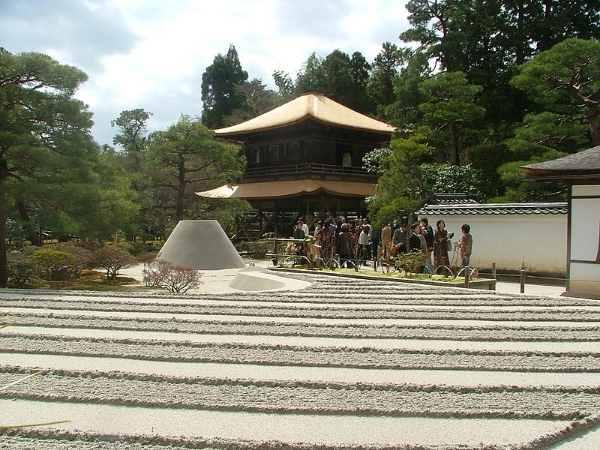Last month, I visited the Yukawa Institute for Theoretical Physics at Kyoto University. Yukawa -- Japan's first Nobelist in physics -- looks to have been an amiable man, so far as one can tell from a statue. He stands watch outside the institute, and when I was there someone had thoughtfully left a food offering (shinsen) on this otherwise secular shrine.
A few bus-stops beyond the university was Ginkakuji -- the Temple of the Silver Pavilion -- a far less secular site, and one of my favourite places on the planet.
Ginkakuji -- Image:Wikipedia
The wooden Kannon-den (the building in the photo) still looks much as it did when it was completed in the 1490s under the aegis of shogun Ashikaga Yoshimasa. (That said, the tranquil complex acquires a darker edge when you learn that Yoshimasa made a Nero-esque retirement there while a war raged outside, during which Kyoto burned and its broad river was jammed with the bodies of the dead.)
The building has a severe charm, but for me, the most memorable aspect of Ginkakuji is the grounds. Specifically, the contrast between the hillside above the temple, which contains a lovingly tended assemblage of mosses and trees, and the haunting geometry of the Zen sand-garden that surrounds the pavilion.
When I visited, I found myself wondering about the practical aspects of Zen gardening. Within the Zen garden, the iconic, Fuji-esque "Moon-Viewing Platform" or Kogetsudai, is a conical mound of sand that stands as high as an adult. Ginkakuji is a World Heritage Site, so the Kogetsudai is almost certainly the world's only UNESCO-listed sandcastle. Unlike a pyramid or a stone temple a sandcastle is an inherently evanescent structure, which must present a challenge to its curators.
A key parameter for any granular material is the wonderfully named angle of repose, the maximum slope a granular material can sustain before it starts to flow. (You can see the angle of repose in the kitchen -- take a bowl of sugar, and tilt it a little. Initially the surface of the sugar stays fixed relative to the bowl, but if you increase the tilt past a critical angle the sugar begins to flow in a series of little avalanches -- and when you return the bowl slowly to the vertical, the surface of the sugar remains at a lean. That's the angle of repose: the highest angle at which the sugar can safely maintain itself.)
For dry sand, the angle of repose is around 30 degrees, a far gentler slope than the walls of the Kogetsudai. So this sandcastle requires artificial assistance. I was curious as to how it holds itself up, and how often it needs maintenance -- surely more than once a day?
Luckily, my visit coincided with a temple worker tending to the Kogetsudai with a pair of wooden trowels and -- aha! -- a no-nonsense watering can, which he refilled several times from the adjacent pond. As anyone who plays in a sandpit knows, a little water does wonders for stability. In small quantities, water creates bonds between adjacent grains, so damp sand holds together more tightly than it does when dry. Now I know how Kogetsudai stays up, although I have yet to see what happens when it rains.
Simple systems with subtle behaviour are playgrounds for scientists. Composed of solid grains, granular materials can flow like liquids in the right circumstances; they are hard to model mathematically, and crop up in fields ranging from geophysics to industrial processing. A few years ago, a paper titled How to Construct The Perfect Sandcastle appeared in Scientific Reports, an offshoot of Nature. The title might be tongue in cheek, but the topic is serious; playing with sand provides work for physicists as well as for gardening monks.
Postscript: I looked, but could find very little information on the web regarding the maintenance of the Ginkakuji gardens, beyond this Youtube video. And my thanks to Jennifer Geard for reminding me of the "angle of repose".




